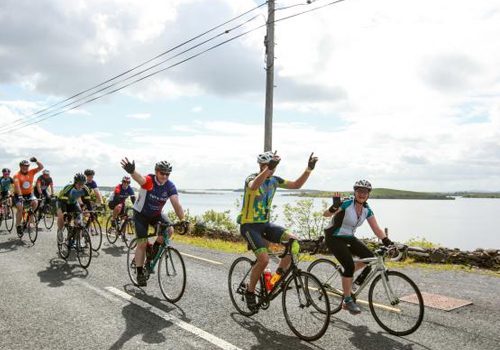Dress for Comfort
Dressing in appropriate cycling gear will make long distance cycling more comfortable. Consider getting yourself a good pair of cycling shorts – tight material is best, as loose shorts may cause chafing and skin irritation. For a the longer distance, such as the Tour de Lough Corrib 120km, invest in pair of padded shorts, these will make a difference to your saddle. If you use pedals with no clips, you'll need to wear special cycling shoes with a cleat fitted to the sole; they lock into a mechanism in the pedals, holding the shoes in place. They can take a while to get used to, but will create a more powerful and efficient cycling experience.
Help Your Muscles
When you get to the top of a long uphill, try not to coast downhill without pedalling. As you climb up the hill, lactic acid builds up in your muscles and can contribute to muscle soreness. By pedalling lightly but constantly while you are coasting downhill—even if there’s little resistance—you can help remove the lactic acid.
Change Positions
When you’re cycling for a long distance it’s important to vary your hand and body position frequently. That changes the angle of your back, neck and arms, so that different muscles are stressed and pressure is put on different nerves. Avoid riding with your hands on the curved part of the handlebars for a long time. This may cramp your hands, shoulders and neck. Keep your arms relaxed and don’t lock your elbows. This will help you absorb bumps better.
Pick the Right Seat
The hard, narrow seats on racing bikes can be particularly uncomfortable for women, who tend to have widely spaced “sit bones.” Special anatomically designed saddles—wider and more cushioned at the back—are easy to install. Gel-filled saddles or pads or sheepskin pads can ease pressure and friction. Position the saddle so that your knee is only slightly bent at the bottom of each rotation. If it's bent too much, the seat is too low; if the knee locks when extended, or you have to reach for the pedal, the seat is too high. Adjust the seat's "fore-aft" position and make sure the seat is level (or that the nose is just slightly higher).
Take it Slow
If you are relatively new to cycling or just back after a long break be sure to start back slowly. Don’t push yourself too hard, too soon. Take 30 minutes a day and cycling on flat terrain for three to four weeks. You can build your intensity and the type of terrain over time and gradually. Adding in hills will help build your fitness. The most important thing is to take it at your own pace and find your comfort zone.
(Adapted from Berkeley Wellness)
